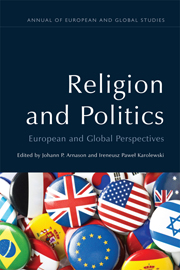Book contents
- Frontmatter
- Contents
- 1 Introduction
- 2 The Religio-political Nexus: Historical and Comparative Reflections
- 3 Politics and Religion in a Global Age
- 4 Comparative Secularisms and the Politics of Modernity
- 5 Europe in the Global Rise of Religious Nationalism
- 6 The European Union's Civil Religion in the Making?
- 7 Democracy, Secularism and Islam in Turkey
- 8 Orthodox Religion and Politics in Post-Soviet Russia
- 9 Religion and Politics, Church and State in Chinese History
- 10 Religion and the State in Contemporary Japan
- 11 Arab Revolutions and Political Islam: A Structural Approach
- 12 Beyond Post-secularism: Religion in Political Analysis (Review Article)
- Notes on the Contributors
- Index
10 - Religion and the State in Contemporary Japan
Published online by Cambridge University Press: 05 September 2014
- Frontmatter
- Contents
- 1 Introduction
- 2 The Religio-political Nexus: Historical and Comparative Reflections
- 3 Politics and Religion in a Global Age
- 4 Comparative Secularisms and the Politics of Modernity
- 5 Europe in the Global Rise of Religious Nationalism
- 6 The European Union's Civil Religion in the Making?
- 7 Democracy, Secularism and Islam in Turkey
- 8 Orthodox Religion and Politics in Post-Soviet Russia
- 9 Religion and Politics, Church and State in Chinese History
- 10 Religion and the State in Contemporary Japan
- 11 Arab Revolutions and Political Islam: A Structural Approach
- 12 Beyond Post-secularism: Religion in Political Analysis (Review Article)
- Notes on the Contributors
- Index
Summary
The relationship between religion and the state in Japan has been the object of investigation in an increasing number of scholarly works in the last decades (for example, Hardacre 1989, 2006; Kisala 1994; Nakano 1996; Forfar 1996; Mullins 2010; the contributions in Porcu and Watt 2012; Isomae 2012; Klein 2012; Fisker-Nielsen 2012; Kleine 2013; Dessì 2013). One of the most intriguing and debated issues in this regard has been the separation of religion and state (Jp. seikyō bunri) as legally sanctioned by the Japanese Constitution (1947), in particular by Articles 20 and 89. Article 20 sanctions freedom of religion for all, prohibits state privileges for religious organisations, and specifies the non-interference of the state into religious education or other religious activities. Article 89 is more related to the financial aspect of this matter and states that no public money should be used for religious activities. Both articles are included in the post-war Constitution of Japan, which was strongly influenced and demanded by the Supreme Commander of Allied Powers (SCAP) after the defeat of Japan in World War II. Historically, it was preceded by the Shintō Directives in 1945 issued by SCAP and was conceived as a way to bring an end to what is known as State Shintō, that is, a system where state support was granted for Shintō from the beginning of the Meiji period until the end of World War II (1868–1945).
- Type
- Chapter
- Information
- Religion and PoliticsEuropean and Global Perspectives, pp. 168 - 182Publisher: Edinburgh University PressPrint publication year: 2014



